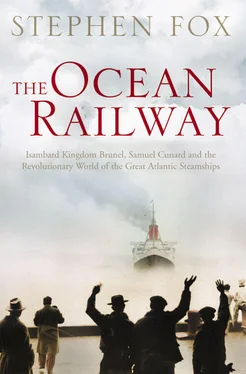This quick success provoked a productive steamboat competition. For some years before the Comet, Bell had worked on steam navigation designs with John Thomson, a Glasgow engineer. Thomson had made sketches of a boiler and machinery, and he expected to help Bell produce his steamboat. But Bell instead went ahead on his own, leaving Thomson angry and disappointed. He took his revenge by building a bigger, faster boat, the Elizabeth. Also constructed by John Wood, she was fifty-nine feet long by twelve feet wide, and forty tons, with a nine-horsepower engine. Her cabin included such touches of luxury as carpets and a sofa, windows with tasselled curtains and velvet cornices, and even a small shelf of books. The Elizabeth ran from Glasgow to Greenock and back every day, instead of only thrice weekly, carrying as many as one hundred passengers at speeds up to nine miles an hour, cutting steadily into Henry Bell’s business.
Over the next few years, steamboats appeared on most of the major rivers of Great Britain. Just before the first railroads, they started to speed and discipline the pace of life, ratcheting up to the predictable, rationalized clock time of the Industrial Revolution. Steamboats ran at man’s pleasure, ploughing along through adverse winds and waves, coming and going as ordered. A clock soon became a necessary instrument for doing business. ‘ The merchant, knowing the time of the tide, can count to an hour, in ordinary weather, when his goods will arrive; and will not be disappointed in one case out of thirty’ Henry Bell asserted. ‘I expect in a short time to see all our ferries, and our coasting trade carried on by the aid of steam-vessels.’
In May 1815, the first long ocean passage by a steamboat in Europe tested steam’s potential for that coasting trade. The Glasgow(later renamed the Thames) had been built by John Wood a year earlier. She showed steady progress in size and power: seventy-two feet long by fifteen feet wide, sixteen horsepower, and seventy-four tons. Sold to London interests for service on the Thames, she put to sea just for delivery to her new owners, not to start a regular ocean service between Scotland and England. Under the command of George Dodd, a young architect and civil engineer, she set forth from Glasgow with an eight-man crew of a master, four sailors, and a cabin boy – and a smith and fireman for the engine.
The Glasgow ran easily down the Firth of Clyde into the narrow channel between Scotland and Ireland. Here she encountered more difficult sailing than anything normally seen on the Clyde, as the ebb tide collided with strong swells sweeping in from the North Atlantic. Unable to make progress, Captain Dodd had to seek shelter in Loch Ryan. The Glasgow ventured out again, was tossed around, and nearly wrecked on the rocky Irish coast. She stopped at Dublin for several days of rest and repairs. Naval officers came to see her, agreeing that she would probably not survive a true stormy sea and had better hug the shore. Watched by thousands of spectators ranged along her way, she left Ireland with just two brave passengers for London.
Away from the coast in the Irish Sea, she again met heavy swells. ‘The movement of the vessel differed entirely from that of one pushed by sails or oars,’ noted Isaac Weld, one of the passengers. ‘The action of the wheels upon the water on both sides, prevented rolling; the vessel floated on the summit of the waves, like a sea-bird. The most disagreeable movement took place when the waves struck the ship crossways; but here too its particular construction gave it a great advantage; for the cages which contained the wheels acted like so many buoys.’ As water flooded into the paddle box on the windward side, the compressed air exploded in an alarming report whose percussive force made the whole boat tremble. This noise exploded again, by reaction, on the other side of the Glasgow, then again, much diminished, on the first side. At this point she at least stopped rolling for a while. ‘During the rest of the voyage,’ according to Weld, ‘the vessel made what the sailors call, a dry way, that is, it danced so lightly over the waves, that it never took in one; and in all the passage we were not once wet…which could not be expected in any common ship.’
As they neared Wexford, at the southeastern corner of Ireland, the Glasgow’s thick coal smoke convinced local pilots that the approaching boat was on fire. They scrambled out to sea, expecting to save lives and perhaps seize some profitable salvage – and were surprised and disappointed that the Glasgow was just steaming along in safety. She crossed St George’s Channel to England, near Cape St David, and was again greeted by a flotilla of would-be rescuers not anticipating a smoking steamboat in those waters. Heavy seas tossed up waves so high that at times the crew of the Glasgow could not see the coast. Captain Dodd picked his way through, leaving far behind a fleet of sailing vessels trying to keep pace. They stopped for two days at Milford Haven for inspections and to scrape the saltwater scale from the boiler, a problem not encountered when sailing freshwater rivers.
Rounding Cape Cornwall into the English Channel, they encountered their highest swells yet. ‘It seemed impossible to pass,’ Weld recalled. ‘The vessel appeared to suffer… Night approached, and no harbour presented itself, except that which we had quitted, and which was already too distant.’ Captain Dodd hoisted sail, which helped steady her, and struggled against the waves for hours until reaching calmer waters. The rest of the trip was smooth and easy. At Portsmouth, tens of thousands of people came out to stand back and be amazed. The Glasgow reached the mouth of the Thames on 11 June, intact and in good order. She had covered 760 miles in a bit more than 121 hours of actual sailing time, spread over almost three weeks.
The voyage showed that a long ocean passage by steamboat was in fact feasible – though not as yet on a routine basis. The apparently insoluble limitation remained the fuel supply. The Glasgow burned two tons of coal every twenty-four hours. Coal was expensive and bulky, requiring inordinate storage space aboard ship and, therefore, frequent landfalls for refuelling. An extended ocean voyage across open water with no coaling stops was still impossible, awaiting bigger ships and the invention of better engines and boilers. It would be more than two decades before a steam vessel could cross the North Atlantic under sustained power.
Scotland produced the first British steamboats and then dominated that field ever after. By 1822, forty-eight steamershad been launched from the Clyde, more than from any other part of the country. Shipbuilders and marine engineers along the Clyde drew from well-entrenched west-of-Scotland traditions of millwrighting, iron smelting and founding, and engineering. Glasgow also lay at the western end of the geologic formation known as the Clyde Basin, rich in coal and iron deposits. All the necessary human and mineral resources were at hand. The river itself was periodically diked and deepened, allowing access all the way to Glasgow for even the newest, biggest steamships. In these burgeoning circumstances, the Napier and Elder families established durable steam shipbuilding dynasties. With an uncanny (and canny) consistency that came to resemble an orderly series of monarchical successions, these two families, their associates, and their lineal descendants in other firms would build and engine most of the notable Atlantic steamships of the nineteenth century.
David Napier, the first of this line, was born in 1790 in Dumbarton, on the Clyde about halfway between Glasgow and Greenock. The men in his family worked as blacksmiths and iron founders. He attended school briefly, acquiring a little Latin and French, but was inevitably bound for his father’s workshop. In 1803 he glimpsed his future when he saw the Charlotte Dundas at Port Dundas, near Glasgow. ‘ Although thenonly twelve years of age,’ he recalled a half-century later, ‘having been reared among engines and machinery, I took particular notice of it.’ David went along when his father moved the family business to a foundry on Howard Street in Glasgow. At the age of twenty, after his father’s death, he took over. In another brush with British steamboat history, he built the boiler for Henry Bell’s Comet. ‘ Not having beenaccustomed to make boilers with internal flues,’ he noted, ‘we made them first of cast iron but finding that would not do we tried our hand with malleable iron and ultimately succeeded, with the aid of a liberal supply of horse dung, in getting the boiler filled.’ (Napier never forgot that Bell had neglected to pay him for it.)
Читать дальше












